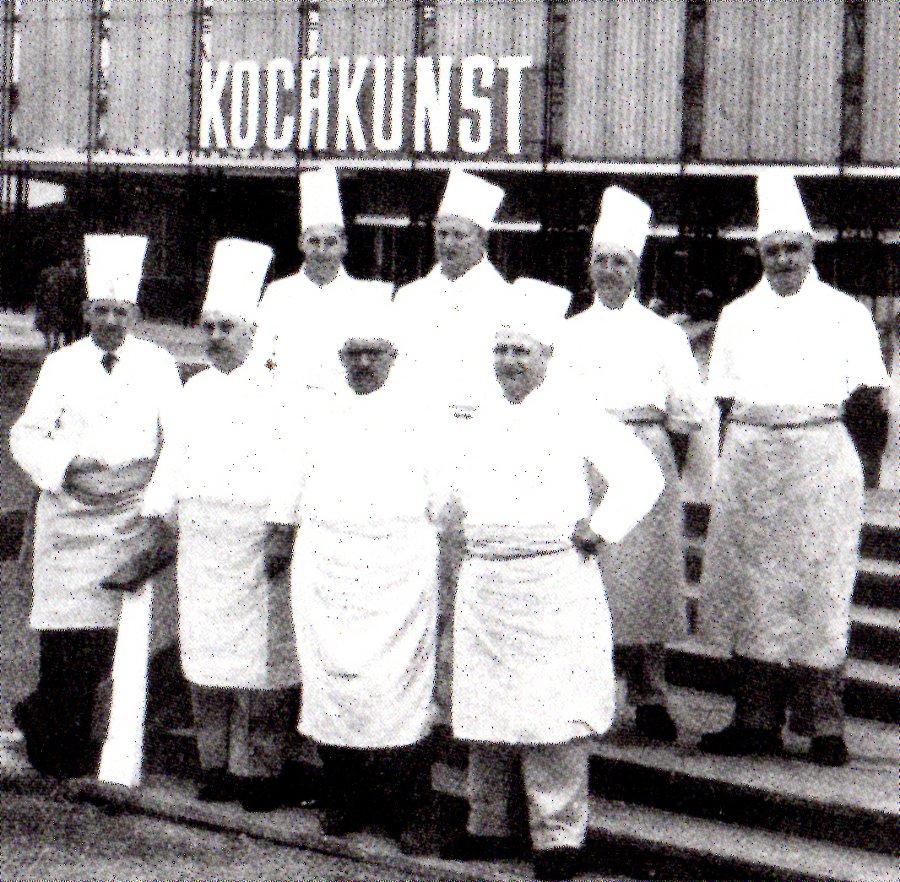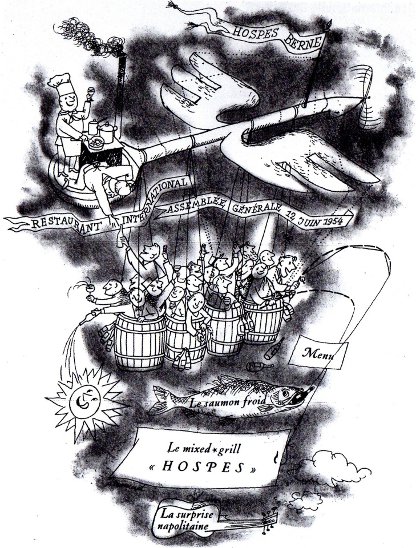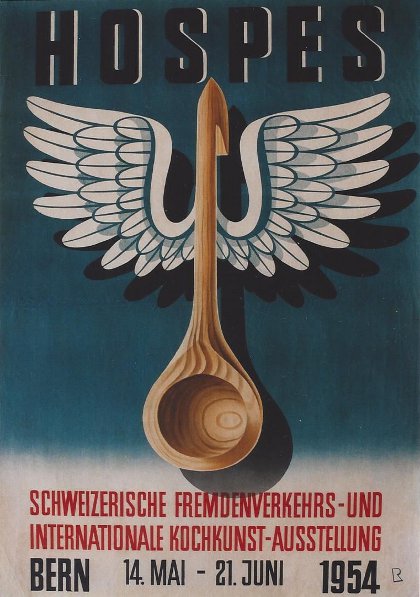An Expo Named HOSPES, Bern, 1954
Swiss National Team, HOSPES Culinary Salon, Bern, 1954

Die Schweizer Koch-Nationalmannschaft Vordere Reihe von links: A. Furrer, A. Conrad (Chef der Equipe), O. Thöni, O. Ledermann
Hintere Reihe von links: O. Hadorn, G. Burkhard, F. Christen, W. Wohler (Patissier)
World War II devastated Europe and dislocated trade and commerce. Nations strove to recover throughout the 1940’s with food rationing continuing in many countries well into the 1950’s. Although Switzerland remained neutral throughout the war, the residual stranglehold of destruction and poverty experienced by its European neighbours stifled growth and prosperity at home.
The Swiss Federal Administration realized that they needed to take an initiative and create an opportunity for nations to build a focus on prosperity by creating growth in trade and travel. Switzerland itself needed a stimulus. The last ‘World Fair’ or Expo held in Europe took place in 1939.
It was time for another Expo. The concept of HOSPES was born and Bern would be the hub, with the target opening date set for 1954.
The Cercle des Chefs de Cuisine Berne (CCCB) was formed on June 21, 1922. The first meeting took place in the Restaurant Bierhubeli. The annual membership fee was set at 5 francs. There followed the first Culinary Salon which was held in the “National” in Bern. The second Salon Culinaire followed in 1924 in Lucerne. The Chefs of Bern continued their monthly meetings during the war years. The CCCB were well established and prepared to contribute to the planning and operation of HOSPES following the leadership of the Hotel & Gastro Union.
HOSPES was a remarkable achievement for that time, in those circumstances. Our focus is on the Hotel Industry and the Chefs participation however many other industries were participants.
The Messe or Exhibition Hall was expansive, covering 170,000 meters. It operated for five weeks from May 14 to June 21 1954. There were delegates from all major European centres and from distant countries such as Japan and America. In total, there were in excess of 750,000 visitors. At that time it was the largest show in Europe with 21 nations trading; each from within their own pavilions. To service and care for these visitors there were 5,000 eager exhibitors and volunteers.
The chefs had their own agenda. First and foremost they had to feed the daily rush of visitors along with the participating exhibitors. All told there were 24 restaurants with the largest having a capacity for 1,500 covers. Here are just a few selections from the available menus…. “Wienerli Sausage & Potato Salad cost 2.0 francs”….”Deli Platter 2.80 francs”…. “Cheese Cake warm or cold 0.50 francs”.
The CCCB also placed an emphasis on education. There were seminars on diets with advice on how to eat healthier. There were also daily cooking shows for the domestic market, one such being: “The various ways of cooking with eggs”. The chefs also operated a library where many cookbooks were available for perusal.
How could any gathering of chefs be complete without a Salon Culinaire? There were chef delegates from 15 nations many of whom were accompanied by their National Teams. A grand competition took place and the outcome was not surprising with Switzerland taking 1st Place followed by Germany in 2nd Austria 3rd and America 4th.Other National Teams represented were from: England; Norway; Sweden; Holland; Belgium; Italy; Canada; Yugoslavia; Denmark; Finland and Spain.
Certainly, HOSPES was a resounding success. The Show itself gave a significant boost to hotels and to the local economy. In addition, it also rejuvenated the Tourism Industry in Switzerland and beyond. There were exchanges of ideas between countries. New methodologies were examined and applied. New trade relations were formed along with partnerships in new endeavours.
The CCCB and the Hotel & Gastro Union had cause to be proud.
|






